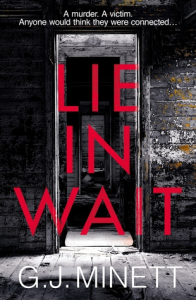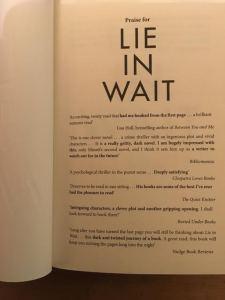
On 9 March 2017 Lie In Wait by G.J. Minett is being published as a paperback and looking inside the front cover I can see that I’m not the only reader to heap praise on this novel

So I was thrilled to be asked to kick off the blog tour to celebrate the paperback publication especially as the author was kind enough to take time out of his busy schedule, which includes submitting book three to the publishers, to write this exclusive post about writing characters!
Writing Characters
All authors have to choose a starting point that works for them and for me it’s the central character. That doesn’t mean to say that potential plots don’t occur to me from time to time – they do, and I tend to shut them away for future reference because until I have a character I want to work with, there is no story to tell. Once I do, I can then look for that character’s Achilles heel and choose a situation that is going to test her/him to the limit. But it’s character first.
In The Hidden Legacy, Ellen sprang out of an exercise we did for the MA in Creative Writing at the University of Chichester. We were given a comprehensive checklist which we had to use to ask our character questions ranging from which newspaper she read to what her deepest fear would be. I took ages over fleshing her out and carried her around with me for months, even asking myself how she would react to news items on TV. Not far off schizophrenic maybe but very useful for getting to know your character.
In Lie In Wait Owen was a composite of a handful of children I’ve taught over the years who seem to have the words ‘natural victim’ stamped into their psyche. Very often they are different but they are made more so by the reaction of those around them who exclude them from everything.
Writing is not just about central characters though and I’ve come up with three tips which work for me when developing the cast of supporting actors who help to bring the novel to life. In no particular order they are:
• Avoid extremes if possible. Not many people are without flaws and no one I’ve met is entirely without redeeming features. Try to make sure you throw in a few little surprises which show a different side to your characters or there’s a danger they’ll be too wooden and stereotypical to be interesting. It’s always better to challenge the reader’s expectations.
• Get the dialog right. We all speak slightly differently from each other with a variety of hesitations, digressions, favorite expressions that, you know, we seem to kind of throw in every other sentence . . . basically. Know what I mean? Listen to people around you, borrow extensively from them. In an ideal world, it should be possible for a reader to listen to a dozen or so examples of speech from one character in your novel and know exactly who it is without being told. And the listening part is important too – try taping an extended piece of dialog you’ve created and playing it back to see what it sounds like. If it clunks, change it.
• Test your characters. You won’t want (or have time) to do this with all of them but with half a dozen or so who appear relatively frequently, try to come up with a situation which will put them under pressure and bring out a different side to them. Characters when pressurised behave in ways that surprise us and readers tend to like being caught on the hop. At any social gathering, I don’t suppose I’m very different from anyone else in seeking out the individuals who are interesting, entertaining and informative and readers are the same. If we can make a character that little bit more interesting, we’re winning the battle for the their attention.
I did say these work for me. It doesn’t mean they will for everyone but if there’s even one small suggestion there that helps, I’ll be delighted.
Many thanks to Cleo as usual for the opportunity.
Thank you Graham, and one of the things I’ve loved most about both books is how realistic the characters are, for me it is the mixture of redeeming, and not so redeeming qualities which tends to convince me but I can see that by employing all of those tips, there is nothing to doubt about how life-like a character is.

G.J. Minett’s first book A Hidden Legacy was published by Twenty7 Books then a new imprint of Bonnier Publishing, specialising in debut fiction from every genre. They are incredibly passionate about supporting the best new authors and finding innovative ways of bringing their books to readers across the world.
Lie In Wait has been published by Bonnier and has already amassed an impressive quantity of five star reviews on Amazon.
You can visit Graham’s author page on Facebook at G.J.Minett author or on Twitter @GJMinett
Lie in Wait
Synopsis
A man is dead. A woman is missing. And the police have already found their prime suspect…
Owen Hall drives into a petrol station to let his passenger use the facilities. She never comes back – and what’s more, it seems she never even made it inside.
When Owen raises a fuss, the police are called – and soon identify Owen himself as a possible culprit – not least because they already have him in the frame for another more sinister crime.
Owen’s always been a little different, and before long others in the community are baying for his blood. But this is a case where nothing is as it seems – least of all Owen Hall…
A dark, addictive thriller, ingeniously plotted with a twist that will make you gasp, LIE IN WAIT is perfect for readers of Angela Marsons or Rachel Abbott. Amazon


